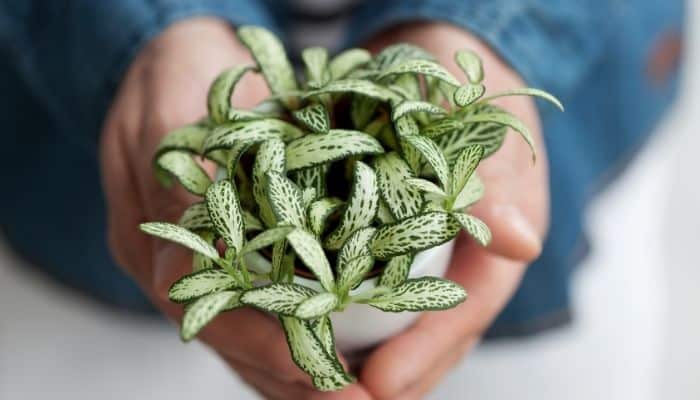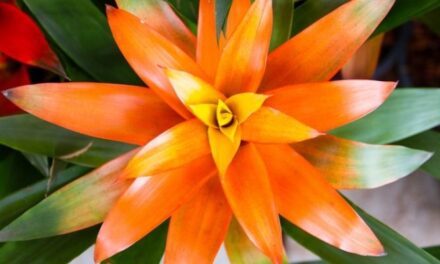We can’t always get our plans to bloom but we do rely on their large leaves to green up our homes.
But sometimes even producing large leaves can be a struggle.
If conditions aren’t just right, your houseplant can sometimes start growing loads of small leaves.
Especially if it’s a tropical plant.
In this article, we’ll look at the reasons for this and what you can do to fix it.
Table of Contents
Why Is My Plant Putting Out Small Leaves?

Your plant may start putting out small leaves if it is not receiving enough light if it is being overwatered, has high levels of salt in its soil, or it has become root-bound.
Let’s look at each of these causes in more detail and see what you can do to help your plant to get back to producing larger leaves.
Lack Of Light Can Cause Your Plant To Put Out Small Leaves
If you brought your plant home and it already had big, beautiful leaves, there’s a chance that it was grown in a nursery or greenhouse.
In this setting, it would have been accustomed to optimal light and temperature conditions.
It can be a shock to your plant when you take it home and the environment is not as warm or bright.
If the area you placed your plant in does not offer it the amount of light It needs, then new leaf growth may become small and immature.
Plants Need Light To Produce Food And Large Leaves
Plants need light to photosynthesize and they need to carry out photosynthesis in order to produce food and grow.
A lack of light can lead to a lack of food.
And this can result in stunted growth and the production of small leaves that stay small.
What To Do:
Identify Your Plant And Its Needs
You first need to know what type of plant you have and the exact conditions it needs to be able to thrive.
Some plants like all the full sun they can get while others can handle little to no direct sunlight at all.
Your plant will probably fall somewhere in between but because it is putting out small leaves at the moment we can assume that it needs more light.
Related Article: Why Is My Plant Growing Sideways? (And How To Stop It)
Provide Your Plant More Sunlight
The solution to this is to find a new bright spot for your plant.
Ideally, it should be a spot that gets lots of indirect light.
Avoid strong direct sunlight unless you know your plant likes it.
You’ll also want to rotate your plant every few days so that it’s receiving an even amount of sunlight.
Your Plant Has Been Putting Out Small Leaves Because Of Overwatering
Overwatering is probably the most serious threat to houseplants.
This common mistake could also be the reason why your plant is growing small leaves.
Overwatering can quickly lead to root rot and abnormal growth.
What To Do:
If overwatering is to blame, you’ll need to lift the plant out of its pot to check on the roots.
If the roots seem okay and the soil isn’t too soggy, allow the soil to dry out before giving it more water.
If any of the roots appear blackish or mushy then you should clip them off and repot the plant.
You may also notice that overwatered plants only put out small leaves towards the bottom of the plant.
These leaves won’t grow anymore, so you should always clip them off to allow new growth to come in.
Your Plant Is Putting Out Small Leaves Because Of An Accumulation Of Salt
There can be a couple of different things that can cause a buildup of salt in your plant soil.
Excess Salt From Fertilization
Each time you fertilize your plant you are adding salt into the soil.
Your plant doesn’t extract all of the salt each time it’s applied and this can lead to a build-up.
When there is excess salt in the soil, it binds to water and stops your plant from accessing it.
This can be a difficult problem to diagnose because your plant’s soil may feel moist even though the salt in the soil is still stopping the roots from absorbing moisture.
And this lack of water can cause your plant to start putting out lots of small leaves instead of normal ones.
Try To Identify The Excess Salt
Look closely at the surface of the soil first.
Excess salt will often form there and resemble little crystals.
You may also notice a buildup of salt at the bottom of your pot around the drainage holes.
Salt From Tap Water
Tap water can also contain high levels of dissolved mineral salts and other chemicals which can impact the health of your plant over time.
Eventually, as you water the plant salts will end up separating from the solution and building up in the soil.
When this happens you may notice a white or yellow ring forming on the soil.
When there is an excess of salt, it can deprive your plant of the water it needs to stay hydrated and healthy.
What To Do If Your Plant Is Suffering From Excess Salt
Re-Pot Or Flush Out Your Plant’s Soil
If you notice a lot of crystals on the surface of the soil and the salt buildup is quite heavy, you’ll be better off repotting the plant.
Take away as much old soil as possible around the roots and repot your plant in fresh soil.
However, if there’s only a small buildup you may remove the layer of salt by removing the top 1/4 inch of soil.
After scraping off the salt buildup, you will need to flush out the soil.
Take your plant over to a sink or somewhere that can deal with the excess water.
Slowly pour a large amount of water into the pot and allow it to saturate the entire bed of soil before draining away out of the drainage holes.
You don’t want to pour the water in too quickly, or else all the water will run down the side of the pot.
Do this a couple of times to flush all the salt out, using double the pot’s size amount of water.
The Best Water To Use When Watering Your Plants
Tap water straight from the tap can have levels of sodium and other chemicals that may harm your plant with prolonged use.
Using distilled water, mineral water, or collecting rainwater in containers is a far cleaner option for water in your plant.
If you do have to use tap water, you can first pour it into a container and leave it out overnight.
That way, many of the harmful chemicals will evaporate from it before you will use it to water your plant.
If excess salt is the reason for your plant producing small leaves and you carry out these steps, your plant should soon begin to produce normal-sized leaves again.
Your Plant Is Producing Small Leaves Because It Is Root-Bound
When your plant becomes root-bound, its roots take over much of the space within its pot because there is no more space for the roots to spread out.
This means the roots are taking over and there is not enough soil to provide the water and nutrients the plant needs to grow.
And plants often react to this by producing smaller leaves.
What To Do:
In this case, the best thing to do is to repot your plant.
Choose a new pot that’s only one or two inches bigger than the previous pot you were using.
Use your fingers to loosen up the roots then place your plant in its new pot with fresh soil and water it.
Remove Small Leaves So Bigger Ones Can Grow
You should also prune the immature growth so that there is space for new bigger leaves to grow.
The plant may look out of balance, but as long as it is placed in an area with adequate light it should begin to grow new larger leaves.
Final Thoughts
You know something isn’t right when your plant starts producing loads of little leaves instead of its usual larger ones.
But, by following along with this guide, I’m sure you can quickly identify the problem and take action so that your plant can get back to growing lovely large leaves again.




